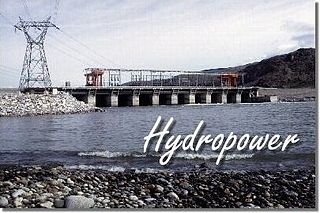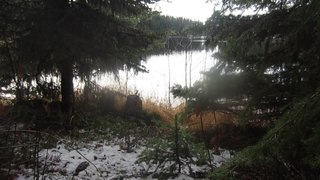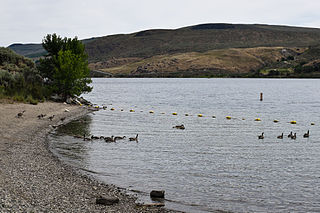
Okanogan County is a county located in the U.S. state of Washington along the Canada–US border. As of the 2010 census, the population was 41,120. The county seat is Okanogan, while the largest city is Omak. Its area is the largest in the state.

Paterospə-TARR-əs is a city in Okanogan County, Washington, United States. The population was 643 at the 2000 census and increased 3.7% to 667 in the 2010 census.

Wells Dam is a hydroelectric dam located on the Columbia River, downstream from the confluence of the Okanogan River, Methow River, and the Columbia River in Washington state. The dam, associated structures, and machinery make up the Wells Hydroelectric Project. It is owned and operated by Douglas County Public Utility District.

The Okanogan River is a tributary of the Columbia River, approximately 115 mi (185 km) long, in southern British Columbia and north central Washington. It drains a scenic plateau region called the Okanagan Country east of the Cascade Range and north and west of the Columbia, and also the Okanagan region of British Columbia. The Canadian portion of the river has been channelized since the mid-1950s.

Franklin D. Roosevelt Lake is the reservoir created in 1941 by the impoundment of the Columbia River by the Grand Coulee Dam in Washington state. It is named for Franklin D. Roosevelt, who was president during the construction of the dam. Covering 125 square miles, it stretches about 150 miles (240 km) from the Canada–US border to Grand Coulee Dam, with over 600 miles (970 km) of shoreline; by surface area it is the largest lake and reservoir in Washington. It is the home of the Lake Roosevelt National Recreation Area.

Alta Lake State Park is a public recreation area located two miles (3.2 km) southwest of Pateros, Washington, at the northern end of 220-acre (89 ha) Alta Lake, in the mountainous northwest interior of the state. The 181-acre (73 ha) state park and adjacent lake lie beneath towering stone cliffs, formed by glaciation, that rise 1000 feet above the valley floor, and carry on up to the top of Old Goat Mountain which sits 4200 ft above the park. A two-mile-long (3 km) road leading to the park, Alta Lake Road, intersects State Route 153, which runs along the Methow River. The park is managed by the Washington State Parks and Recreation Commission.

The Methow River is a tributary of the Columbia River in northern Washington in the United States. The river's 1,890-square-mile (4,900 km2) watershed drains the eastern North Cascades, with a population of about 5,000 people. The Methow's watershed is characterized by relatively pristine habitats, as much of the river basin is located in national forests and wildernesses. Many tributaries drain the large Pasayten Wilderness. An earlier economy based on agriculture is giving way to one based on recreation and tourism.

The Okanagan Highland is an elevated hilly plateau area in British Columbia, Canada, and the U.S. state of Washington. Rounded mountains with elevations up to 8,000 ft (2,400 m) above sea level and deep, narrow valleys are characteristic of the region.
U.S. Route 97 Alternate is an alternate route of US 97 within the state of Washington. It runs for 40 miles (64 km) from Wenatchee to Chelan, following the west bank of the Columbia River opposite from US 2 and US 97. The highway travels through sparsely-populated areas along the river and passes near the Rocky Reach Dam and through the town of Entiat.

Crab Creek is a stream in the U.S. state of Washington. Named for the presence of crayfish, it is one of the few perennial streams in the Columbia Basin of central Washington, flowing from the northeastern Columbia River Plateau, roughly 5 km (3.1 mi) east of Reardan, west-southwest to empty into the Columbia River near the small town of Beverly. Its course exhibits many examples of the erosive powers of extremely large glacial Missoula Floods of the late Pleistocene, which scoured the region. In addition, Crab Creek and its region have been transformed by the large-scale irrigation of the Bureau of Reclamation's Columbia Basin Project (CBP), which has raised water table levels, significantly extending the length of Crab Creek and created new lakes and streams.
The Nespelem River is a northern tributary of the Columbia River, in the U.S. state of Washington. It is completely contained within Okanogan County and the Colville Indian Reservation.

State Route 153 is a 30.78-mile (49.54 km) long state highway in the U.S. state of Washington, serving as part of the Cascade Loop in Okanogan County. The Methow Valley Highway begins at an intersection with U.S. Route 97 (US 97) in Pateros at the confluence of the Methow River and the Columbia River. SR 153 travels northwest, parallel to the Methow River, to end at SR 20 south of Twisp. The highway was first established in 1897 as the Methow-Barron Road and was designated as various highways, including State Road 12 from 1905 to 1919, the Roosevelt Highway from 1919 to 1923, and Primary State Highway 16 (PSH 16) until the 1964 highway renumbering, when it became SR 153.

The Okanagan Country, also known as the Okanagan Valley, is a region located in the Canadian province of British Columbia, and the U.S. state of Washington, defined by the basin of Okanagan Lake and the Okanagan River. With an estimated 400,000 residents, the Okanagan Country spans from the Thompson Plateau near Grindrod, British Columbia in the Okanagan to the Okanagan Highland near Douglas County, Washington in the Okanogan. The largest city in the Canadian portion is Kelowna, with a metropolitan population of 194,882 residents as of 2016, while the largest city in the American portion is Omak, with 4,881 residents as of 2011. The region took its current name in honor of the Okanagan term, ukʷnaqín. The mild climate and close proximity to lakes, rivers and mountainous regions make the Okanagan Country an outdoor recreational destination. The region's economy is dominated by the primary industries of agriculture and forestry, although economic diversification has also occurred with retirement communities and recreational tourism. The American portion is considered to be more remote than the Canadian division, with approximately 10 percent of the population.

Yale Lake is a 3,780 acre reservoir on the Lewis River in the U.S. state of Washington. It lies on the border between Clark County and Cowlitz County. It was created in 1953 with the construction of Yale Dam.

Lake Bonneville is a reservoir on the Columbia River in the U.S. states of Oregon and Washington. It was created in 1937 with the construction of Bonneville Dam. The reservoir stretches between it and The Dalles Dam, upstream. It lies in parts of three counties in Oregon and two in Washington.

Bridgeport State Park is a public recreation area located two miles east of Bridgeport, Washington, on the north shore of Rufus Woods Lake, the Columbia River reservoir created by the Chief Joseph Dam. The state park was built through a partnership between Washington State Parks and the Army Corps of Engineers after completion of the dam in 1955. The park's 25-year lease was renewed in 1990 and again in 2015. The park covers 622 acres (252 ha) which include 7,500 feet (2,300 m) of shoreline, camping areas, four miles (6.4 km) of hiking trails, and facilities for boating, fishing, swimming, and golf.
Foster Coulee is a coulee in Douglas County, Washington. Like the larger Moses Coulee nearby, it was formed during the Missoula Floods at the end of the last ice age, some 14,000 years ago.
Pearrygin Lake is a 212-acre (86 ha) reservoir lying 1.5 miles (2.4 km) east of Winthrop in Okanogan County, Washington. It has a maximum depth of 49 feet (15 m) and has a water volume of 6,260 acre feet (7,720,000 m3). The lake is fed by a diversion from the Chewuch River and several small inlets; it drains westerly into the Chewuch River. It lies within the watershed of the Lower Chewuch River.














